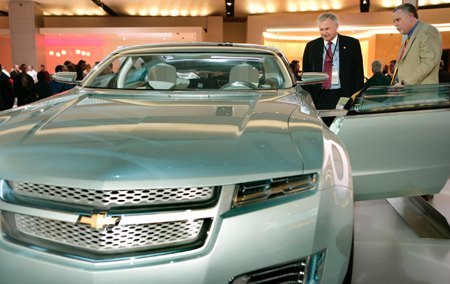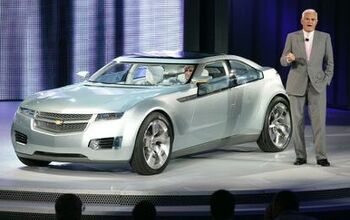2 Views
Volt Birth Watch 2: GM's E-Flex Propulsion Systems Geek Speaks… Again
by
Robert Farago
(IC: employee)
Who killed the electric vehicle? Range and recharge times. Alt propulsion supporters are happy to compromise “normal” modern day purchase parameters– a car’s looks, acceleration, cargo capacity, passenger space, safety, towing, convenience, range, price, etc.– to cater to their political or environmental beliefs. Mainstream consumers are not. In other words, GM’s EV1 was not a mainstream vehicle. Hence its demise. The question for GM’s E-Flex Propulsion people now becomes: will the Volt EVer be ready for prime time? If so, will it be ready in time, or will transplant technology pass it by? Press play below for Part two of my interview with E-Flex Propulsion Systems' Line Director Tony Posawatz.
Robert Farago
More by Robert Farago
Published April 1st, 2007 1:41 PM


































Comments
Join the conversation
If the VOLT currently has a 28 mile ALL ELECTRIC RANGE and a TOTAL RANGE of over 500 miles (over 650 miles in one report) before refueling with an mpg of about 50 mpg (combined/highway?) ... isn't that a 40 or 50 mpg combined average hybrid ... without plug-in! If GM used a modular upgradable battery pack that allowed a field trade-in upgrade retrofit (like the PC feature cards) ... they could be in the market today ... if they REALLY WANTED TO!?? The 40 mile "all electric range" could then be up-graded when the battery technology arrived ... soon or never!
Drew (4/2/07): "I don’t know where you get the 2x to 4x “figure” from. The new combined cycle turbines (whether they’re coal or natural gas powered) are approaching 60% efficiency. Transmission losses to get the power to your house are negligible - about 1%." I'm not certain about you electrical engineering background. So here goes a rough analysis: 1 stepup transformer (probably really 2) and 3 stepdown transformers plus transmission lines each with about 2% loss results in a 91% efficiency plus your 60% generating efficiency results in a 46% loss to the "wall outlet". Then add the efficiencies of the vehicle power conversion/charging system, batteries, motor controls, and motors at 99% efficiency each results in 95% efficiency for the vehicle. Overall efficiency for te total system is about 50% (assuming the high efficieny gas fired turbine generators ... generally used for peak management). So if the VOLT requires 0.5 kwhr/mile that translates to 1 kwhr at the generator (in round numbers) or about the equivalent of 1/40 of a gallon of bio diesel. It should be noted that by 2010 Europe will have one or more vehicles that will get 2 miles out of that 1/40 gallon of diesel! As far as electrical power generation goes, it is my understanding that substantually more than 50% of the base load is provided by coal fired plants (most of which are older systems at lower efficiencies that have not been upgraded to significantly reduce emissions) ... not nuclear! I do agree that gas fired facilities (usually spinning reserve) are about 66% cleaner than coal. I am not trying to say that EV's are "bad" only that they do pollute at "remote" locations. And that in the total scheme of things, they are about equal to "traditional" vehicle technology for gasseous, particulate, and thermal emissions. The downside for coal fired energy sourcing is a set of fairly "bad actors" like sulfur, mercury, CO2, and particulates ... plus others based on the coal source.
All hybrids are marketing stunts. At least GM is not wasting money they don't have on actually building them. If you want 50mpg, match the Prius's pathetic performance by driving around in 4th gear all the time or better yet, get a Japanese car from the 80s and enjoy it's 14 second 0-60 time and comparable milage.
How does the volt compare to the Opel Corsa diesel/electric hybrid? http://www.greencarcongress.com/2007/08/gm-opel-to-pres.html